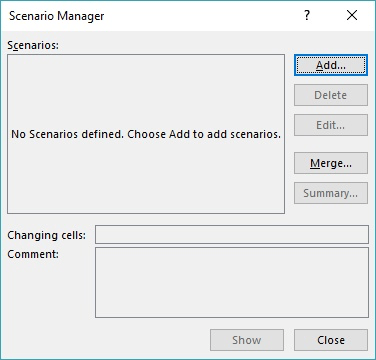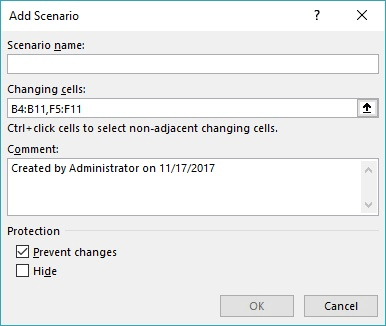Please Note: This article is written for users of the following Microsoft Excel versions: 2007, 2010, 2013, 2016, 2019, 2021, 2024, and Excel in Microsoft 365. If you are using an earlier version (Excel 2003 or earlier), this tip may not work for you. For a version of this tip written specifically for earlier versions of Excel, click here: Creating Scenarios.
Written by Allen Wyatt (last updated November 29, 2025)
This tip applies to Excel 2007, 2010, 2013, 2016, 2019, 2021, 2024, and Excel in Microsoft 365
You already know that Excel provides the ability to play "what if" with your worksheets. As an adjunct to this capability, Excel provides the Scenario Manager, which allows you to save different data scenarios. Using this tool, you can save different variables for your sheet and call them up quickly and easily.
As an example, let's suppose that you work for Talbot Industries, and you have been charged with developing a profitability analysis for a new product—the Potato Chip Peeler. You develop your sheet, taking into account all the appropriate information. However, you know that it is prudent at your company to actually prepare three forecasts. The first would be the worst-case scenario, the second is the most-likely scenario, and the final is the best-case scenario.
To save a scenario, follow these steps:

Figure 1. The Scenario Manager dialog box.

Figure 2. The Add Scenario dialog box.
Once you have a scenario saved, you can make changes to your workbook and save your changed figures under a different scenario.
ExcelTips is your source for cost-effective Microsoft Excel training. This tip (8567) applies to Microsoft Excel 2007, 2010, 2013, 2016, 2019, 2021, 2024, and Excel in Microsoft 365. You can find a version of this tip for the older menu interface of Excel here: Creating Scenarios.

Excel Smarts for Beginners! Featuring the friendly and trusted For Dummies style, this popular guide shows beginners how to get up and running with Excel while also helping more experienced users get comfortable with the newest features. Check out Excel 2019 For Dummies today!
If you've defined a variety of scenarios for your workbook, Excel can provide a handy way to compare the effects of those ...
Discover MoreWhen you create and save scenarios in a workbook, you can later pull them out and display them. Here's how to do it.
Discover MoreOnce a scenario is defined and saved, you can later revisit the values you created for the scenario and modify them. ...
Discover MoreFREE SERVICE: Get tips like this every week in ExcelTips, a free productivity newsletter. Enter your address and click "Subscribe."
2025-11-29 20:22:39
Here are some additional hints for working efficiently with scenarios:
To make full use of scenarios it is important to understand how cells with formulas will be treated if you include them in scenarios. When you select a scenario, the contents of these cells will be replaced with the value that such a cell displayed when the scenario was created. It will overwrite any formula that was there, which will prevent any calculations to adjust when you select a different scenario. In effect, all your scenarios will become static.
It is relatively easy to avoid such complication by including only the input cells, i.e., those that have values specific to your scenario in the range of changing cells. None of the formula cells should be included. That way, showing a different scenario will automatically recalculate all formulas - making you worksheet fully dynamic.
I use the following trick to make creation of scenarios easier: highlight the input cells with light green color, and the calculation cells with light yellow. If your scenario has many non-contigous changing cells, you can create a named range for them to easily select them when creating additional scenarios.
The scenarios are specific to a sheet, so they cannot include cells from other sheets. To overcome this limitation you can link a cell on another sheet to a cell on a scenario sheet (part of changing cells).
Remember also that the changing cells may contain text, not only numbers. It is a good practice to have one of them to contain the current scenario name
Also, it is best for all scenarios you create to have the same range of changing cells. Otherwise, some cells may stay inadvertently unchanged when you display another scenario.
If you need some help with using scenarios for a particular purpose send me an e-mail (I disclosed my address in this post) or post a comment here. I may be able to help. In particular, when you want to create a spreadsheet for other users that makes selection of scenarios easy by selecting a scenario name from a drop-down list in a cell.
Got a version of Excel that uses the ribbon interface (Excel 2007 or later)? This site is for you! If you use an earlier version of Excel, visit our ExcelTips site focusing on the menu interface.
FREE SERVICE: Get tips like this every week in ExcelTips, a free productivity newsletter. Enter your address and click "Subscribe."
Copyright © 2026 Sharon Parq Associates, Inc.
Comments